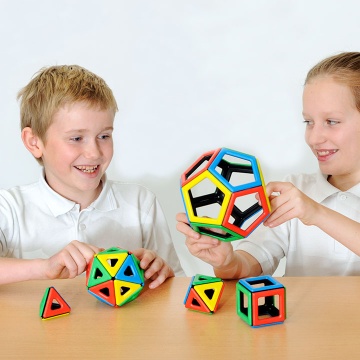My Life with Polydron!
I bought my first pack of Polydron in 1990. It was from the Early Learning Centre, it was a cube with a number of triangles packed inside, a nice desk toy that demonstrated the possibilities of what can be created with a few squares and triangles.

It wasn't long before Polydron (not just squares and triangles) formed a significant element of a new maths exhibit in Light on Science at the old Birmingham Science Museum. Visitors young and old treated us to some wondrous creations, where some visitors even experienced 'original thought' by proving there were only five regular solids (so what that someone had done it before!).
In 2000 I developed Maths in a Suitcase, a travelling hands on maths road-show which I take into schools. Polydron sat with a cluster of other activities where children of all ages could explore shape and structure. The Polydron was used in a number of ways depending on age and experience. For some it was simply the act of making anything - a space ship or hamster run - for some it was making and naming particular shapes, for some it was about exploring regularity.

Five years ago I was introduced to Magnetic Polydron. This was particularly good for the younger child, they could produce 3D shapes instantly without having to learn how to click pieces together - it was an instant hit. Some children want to just create, others like to look at the pictures and create what they see. Translating a 2D image into a 3D reality is an important skill that so often is not developed.
Magnetic Polydron was an instant hit with me as well. By being able to construct shapes quickly, I am more able to engage children in conversation. Sometimes these conversations may be simply around the number of edges or vertices a shape may have, or it may be around concepts like regularity and proof - there's something lovely about discussing the Platonic solids with a 10 year old and seeing that they get it. There's an even warmer feeling when you see the same pupil telling someone else!
I spend around 70 days in schools a year with Maths in a Suitcase. Around 12,000 children engage with my Magnetic Polydron set, or to put it another way, that's 350-400 hours of continuous use! It is mostly 5 years old, still looks good, it doesn't wear out, though it needs topping up occasionally. Why am I so enthusiastic about Magnetic Polydron? Because:
- it works - both physically and intellectually
- it feels good (it allows me to introduce words like 'ergonomic'!)
- it's safe - I have put it in a vice, hit it with a hammer, it doesn't break or chip

It goes without saying that Magnetic Polydron will continue to be important part of Maths in a Suitcase. However, I am now very excited because I am going to include a Magnetic Polydron activity in my Science in a Suitcase - hands on science road-show. The recent introduction of the hexagon means that I can put together an exhibit around the Buckminsterfullerine, so-called buckyball, or C60 molecule (and also talk about football !).
Selwyn van Zeller
Maths in a Suitcase / Science in a Suitcase